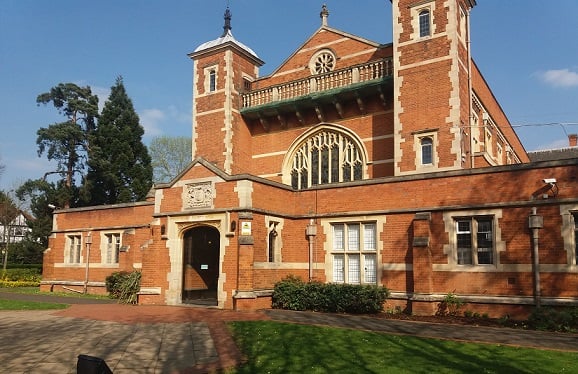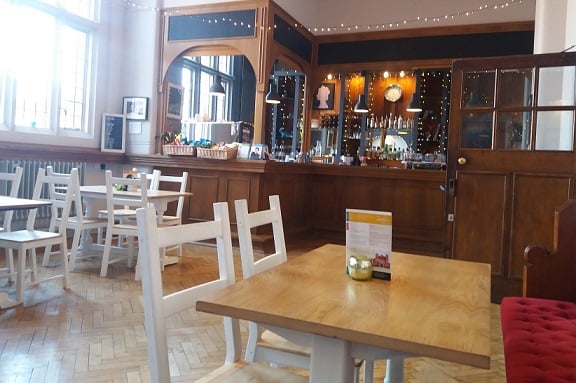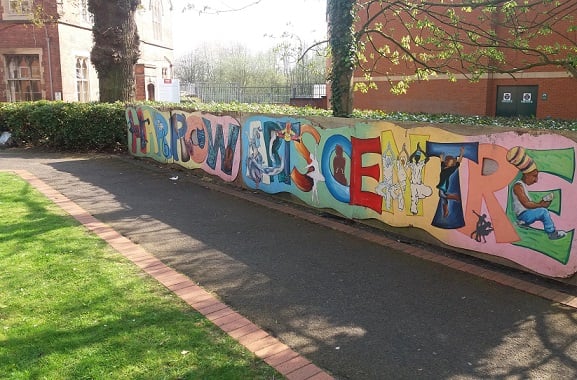
The £17m plan for Harrow Arts Centre involved cinemas, a 600-seat theatre and a gallery
Why a council pulled the plug on a £17m arts centre
What lessons can be learned from Harrow Arts Centre about the complex and risky business of moving arts services into independent trusts? Christy Romer investigates how a dream turned sour.
In August 2014, after years of grappling with what to do with Harrow Arts Centre – a popular red-brick arts centre, which had been running at a £500k loss – the local council proposed shutting it down. The building was a prized asset, but much like other local authorities, Harrow Council couldn’t afford its upkeep alongside the need to make millions in savings.
Predictably, local residents were outraged. They collaborated on a series of petitions, got the press involved, and by November 2014, 18,000 belligerent citizens had called on Harrow Council to make a U-turn.
Within months, it looked like councillors had found a solution: Cultura London, an independent charitable trust. The Council would hand over the running of the arts centre, the school music services and the local museum to Cultura, reducing its subsidy to zero, and the trust would work towards an ambitious redevelopment project. Praises were sung by local residents, the council pledged to support Cultura “every step of the way”, and the project was given the official go-ahead in January 2016.
Fast forward to September 2016 and Harrow Council publicly announced it was going in a different direction. Negotiations resumed, and although Cultura had raised £3.1m towards the project, at the end of March 2017 the trust was informed their vision had been officially dissolved and they were allegedly locked out of their buildings. Secured funding dropped off the table, Cultura accused the Council of excessive bureaucracy, one big charity backer called the Council “disgraceful”. But the Council believes it did everything within its power to see the shared vision become a reality.
What happened? And as other local authorities weigh up how to sustain their arts services in the face of increasing public funding cuts, what lessons can be learned from the failure in Harrow about the complex relationship risks involved in moving services over to independent trusts?
A South Bank for North London
“It may be that we’ll find we did err on the side of caution too much. But the arts centre is not ours to risk.”
Although Harrow is a relatively wealthy borough, with one the largest proportion of millionaires per square mile in the country, it has been tasked with making £83m in savings by 2018. Speaking in 2016, Harrow Council Culture Chief Sue Anderson said Harrow Arts Centre could only survive if it were financially successful, as the Council “can no longer afford to subsidise it”.
In stepped Cultura’s ambitious, four-phase, £17m development plan. The idea involved major improvements to the arts centre’s current performance space, the Grade II-listed Elliott Hall; a new two-screen independent cinema complex; new rehearsal and studio spaces for artists and performers; a new 600-seat theatre; and commercial facilities, including a bar, restaurant, art gallery, café and shop. Revenues from the independent cinema would be used to shore up the local museum.
When the Council officially backed the plan in January 2016, it did so with one proviso: £2.8m had to be raised to support the art centre’s redevelopment. The Council was prepared to provide a £1m loan, but if 90% of the capital fundraising had not been realised by July 2016, the project would be paused and the Council would reassess its position.
Fundraising and the lease
But by the July 2016 deadline, the anticipated funding had not come forward. Cultura had been awarded a £600k loan from Nesta’s arts impact fund, and smaller amounts in donations, but was off the pace in securing funds.
This led the Council to declare it would be “irresponsible” to put any more public money into the project, saying “the challenge proved too great, with neither local fundraising nor grants and industry funding hitting their original targets”. But Cultura said the issue wasn’t the length of time allocated to fundraising, or insufficient fundraising capacity – simply that fundraising for the project was a non-starter.
£3.6m in HLF funding was already in place with the Council, and Cultura wanted to apply for more as part of its plan. But according to Cultura, in order to access more, the trust needed to have control over the whole lease, to enable it to sell – or ‘assign’ – the building to some other entity, or sub-let parts of the building to tenants. Cultura Chief Executive Sandra Bruce-Gordon said a range of options were put in front of Harrow Council, but the Council turned these down as it was “unwilling to bear any risk whatsoever”. The Council said it suggested a lease in two stages, though identified a “lack of enthusiasm” from the Cultura trustees for such an idea.
Anderson explained: “We couldn’t find a lease that would satisfy Cultura’s requirement to get grants and loans for the property, which would also give the Council security that if anything went wrong with the Cultura model, we wouldn’t end up with a site which was vacant for 60 years or being used for purposes we weren’t very keen on.”
Actual funding for the project was another issue. Although £3.1m was eventually on the table by the end of 2016, this mainly came from two sources, and in the form of two loans: one for £2.5m from the John Lyon’s Charity, and one from the Arts Impact Fund. This wasn’t what the Council had originally expected.
Bruce-Gordon said attempts to access grants from various public sources for the first stage of the project – creating a commercial cinema – didn’t fit with funders’ criteria. “It was very difficult with the speed we were required to bring the funding in to get public funding, so it was decided to go for a loan.
“We did have a plan, and we did speak to an awful lot of people and trusts and foundations who were interested in the project,” she said, stressing that it’s common for a project to begin without 100% of the funding in place. “But unless you are physically running the services, they can’t commit to you.”
She continued: “The philanthropic giving could only have happened once we had a lease. We couldn’t have gone to a wealthy individual and said ‘would you be prepared to back us’. We had no legitimacy. We didn’t have a lease. And that’s why that part of the business plan didn’t start.”

The Council said they discussed the guarantee that if Cultura were to go bust, the building would have to pass to another operator with the same cultural intentions. But the local authority was disturbed by the possibility that it would have to pick up the bill at some point and ultimately concluded that the risk was too great.
“You can have a deed which says a building may only be used for cultural purposes,” Anderson said. “But actually, if you get to that point and nobody wants to take it over, what do you do?”
“We didn’t think it was incumbent on us to tie up the fortunes of the Council in that way.”
Chicken and egg
These two intertwined issues point to an underlying problem: a failed relationship between Cultura and the Council.
Much like any transfer of services, arranging a lease is a negotiation. To access funding, Cultura needed the right sort of lease. But the Council wouldn’t agree to this until it was satisfied there was enough of the right sort of money in the project to spread the risk. And because it couldn’t get the lease, Cultura said it couldn’t get more grant funding or public donations, which in turn increased the risk for the Council.
Although theories abound that the ‘actual’ intention for the site was for it to become housing or council offices, this seems unlikely. One private letting agent, who asked to remain anonymous, explained that the requirements sought by the Council were commonplace. Any commercial organisation would do the same to ensure that they maximised returns and minimised risk, and it was not unusual to find that negotiations would break down on this point.
Both sides were committed to the idea. The Council turned a £1m loan into a £1m grant and extended the lease on the building to 90 years. Cultura was flexible with its financial arrangements, produced a vision that excited the public and the press, and found a way of raising the requisite amount of money.
And both sides respected the needs of the other. The Council was aware that the Cultura business plan required an initial period of delivery without income, and Cultura understood the need for Harrow Council to shoulder £83m cuts between 2014 and 2018.
But at the point at which Cultura turned towards a large backer, it needed to somehow convince the Council that the business case was just as plausible. This failed to happen, and the project spluttered into non-existence.
Comparing like with almost like
Funder John Lyon’s Charity had a different interpretation. In its view the Council was entirely at fault, having treated the trustees in a “disgraceful” way. “Numerous effective local authorities around the country have managed to overcome these issues in the interests of successful asset transfers to charitable trusts, which are becoming a frequent feature in the national landscape,” said former Chief Executive Andrew Stebbings.
A useful comparator is Wandsworth Borough Council (WBC), which went through a similar experience with Battersea Arts Centre (BAC). While there are distinctions – unlike Cultura, BAC had been running successfully for decades – the lessons are useful.
By their own admission, WBC and BAC had a pretty ropey relationship around 2008. From 1980 to 2008, BAC occupied the site on a string of short-term leases, which “did not allow for sufficient investment in maintenance”. The asset transfer of the centre occurred in 2008, before a 120-year lease was granted with an initial rent-free period of 20 years.
BAC Artistic Director David Jubb explained that questions had been raised about what would happen if the BAC Trust became insolvent. Through extended negotiations, a “deed of dedication” solution was found, which essentially guarantees the BAC site will be used for cultural purposes throughout the entirety of the lease. Jubb was keen to emphasise that this was not a “silver bullet”, but that it does create the circumstance in which HLF lawyers, council lawyers, and BAC lawyers could work out an amicable solution.
“One of the things in our favour – the track record of the organisation – gave a level of confidence and pressure to find a solution,” Jubb said.
Jubb also emphasised the role of then BAC Chair Nick Starr – former Executive Director of the National Theatre – who held clout with the Council and helped negotiate the long lease and peppercorn rent, arguing BAC needed financial flexibility to undertake the millions of pounds of work the building needed.

Jubb said the renegotiation was a turning point in BAC’s relationship with the Council, which was framed as an opportunity to hand over an asset.
“This was as much about relationship-building as it was about the fine legal points,” Jubb said. “We’d had a strained relationship with the Council, and sorting this out has led us to become collaborative. We have councillors on our board – who therefore can’t advocate for us at council – but that’s a really useful and effective way of sorting out the situation.”
He added: “The Council can be really proud of this.”
Looking forwards
It’s anyone’s guess what will happen next to Harrow’s arts centre. Anderson said council officers are working on various plans to make sure funding comes in for cultural activity in the borough, and the loss of elements of funding are absorbed.
She told AP there were no real concerns for funding the local museum or the school music service, and these groups can still use the arts centre for concerts. She added funding is in place for 2017-18, as it would have been “unreasonable” to expect Cultura to make up that gap.
“But obviously we haven’t set the budget for 2018-19 yet,” she continued. “The assumption was this funding would be something we no longer had to concern ourselves with. So obviously we’ll be having to look at that again when we set the budget, and see what happens.
“Our intention is to keep it as a site for cultural activity. But next year, Government may cut our grant by another 50% and then we’d have to make sure old people aren’t lying in bed in need and unattended.”
Easy as it would be to assume the Council made a backwards decision, lacking in courage, which will deprive a community of a valued asset, it’s important to acknowledge that the consequences for them of taking a risk that doesn’t work out are serious – not least when their own funding from Government is continually under threat. “It was really difficult because we would’ve loved to take the money and get it done, but it was just too difficult,” Anderson said. “It may be that we’ll find we did err on the side of caution too much.
“But the arts centre is not ours to risk.”
And although Bruce-Gordon remains concerned about lease conditions for accessing public funding, she accepted the result: “It’s a Council decision and we stand by that. We’re not saying it’s wrong, because the Council make the decisions on behalf of their constituents, and they make decisions that they think are in the best interests of them. If the risk they thought was too much for their constituents to bear, then they’ve made the decision they have.
“And regrettably, there are ramifications in that for everybody involved, and sadly a group of really dedicated people have – like Sue Anderson said – spent two years of their life trying to make something wonderful happen. You just have to accept it.”
Christy Romer is a journalist at ArtsProfessional.
Join the Discussion
You must be logged in to post a comment.